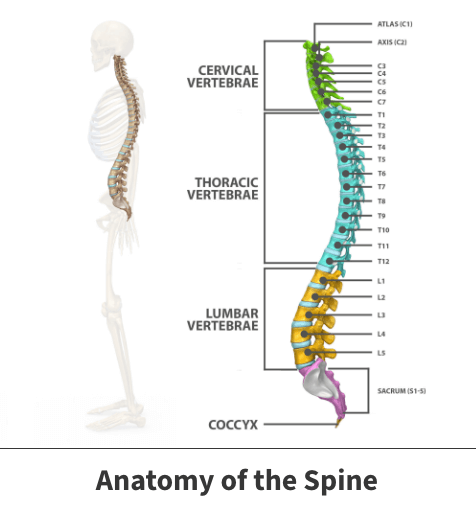Kyphoplasty (balloon vertebroplasty)
The spine is the most important physical component inside your body. It provides the structural framework enabling you to stand, move, and perform any other type of action. The spine comprises many essential nerves that control life-sustaining functions like breathing and bowel and bladder control.
Even the most minor spinal injuries could have serious consequences. Particularly concerning issues include vertebral fractures. Fortunately, these can be fixed through a surgical procedure that restores damaged vertebrae. This procedure is known as kyphoplasty or balloon vertebroplasty.
Anatomy

Your backbone is made up of many small, bone-like structures called vertebra. The backbone provides the passageway for which your spinal cord forms and extends.
About
Over time, vertebrae can weaken. Should they weaken significantly, you stand at an increased risk of developing cracks which are medically referred to as vertebral compression fractures.
Causes
Compression fractures often occur because of long-standing bone-weakening diseases like osteoporosis. Such injuries might also occur following immediate traumatic events, such as car accidents, forceful physical contact, or severe falls. Researchers have found that moderate to severe osteoporosis is typically the underlying cause impacting roughly 750,000 individuals each year.
Cancerous tumors are another underlying factor. Some cancers spread to the back and spinal regions. As these illnesses progress, they can inflict vertebral damage, eventually leading to fractures.
Risk factors
The most significant risk factors are gender and age. For example, women are more likely to develop vertebral compression fractures than men. Up to 40 percent of women over 80 are thought to encounter this type of injury at some point.
Age increases one’s chances significantly. As you grow older, your bones naturally grow weaker, which can increase your chance of developing compression fractures. The risk for osteoporosis also increases with age.
Symptoms
In many instances, the most noticeable symptom is sudden back pain.
Pain may be accompanied by:
- Difficulty standing and walking
- Increased level of pain when engaging in movement
- Pain eases when you lie down
- Limb numbness
- Leg tingling
- Mobility concerns
In severe cases or as the condition progresses, you might experience a loss of height.
Complications
If not addressed as soon as possible, compression fractures can result in spinal deformity, which might interfere with your ability to stand up straight or perform even the slightest physical activity. Fractured bone structures can also press on spinal nerves. This can eventually result in significant nerve damage and associated disability.

Diagnosis
Your doctor starts to reach a diagnosis by performing a thorough physical examination by documenting your medical history and executing a visual evaluation.
Diagnosis is often confirmed using diagnostic imaging tools, such as:
- MRI (magnetic resonance imaging) scan – An MRI allows doctors to capture 3-D images of your back and spine to identify any abnormalities
- X-rays – Internal images that enable doctors to identify problems like bone alignment problems and disc deterioration
- CT (computerized tomography) scan – A CT or CAT scan uses images to reveal the spinal cord’s shape and size
- Bone densitometry – This evaluation measures bone density, often a benchmark statistic that confirms osteoporosis’s presence
Treatment
Balloon vertebroplasty has been used to treat compression fractures since the early 1990s. This procedure is considered minimally invasive, taking only one or two hours to complete. Often it can be performed on an outpatient basis or only needs one night in the hospital.
The process
Once a patient is administered either local anesthesia, intravenous or general sedation, your orthopedic surgeon uses an X-ray to guide a balloon equipped with acrylic cement. This powerful binding material is injected into the fractured vertebrae to fix and stabilize the injured backbone.
Who is a candidate for balloon vertebroplasty?
This procedure may be right for you if you meet the following criteria:
- You have been diagnosed with vertebral osteoporosis causing compression fractures resulting in pain and other symptoms
- The problem has led to bone deterioration or bone death caused by a lack of blood supply
- You have been diagnosed with some form of cancer
- You have the presence of abnormal but newly formed blood vessels referred to as hemangiomas
This procedure is not advised if you have:
- A compression fracture that has responded favorably to other treatments
- Curvature of the spine
- Spinal compression that is not caused by compression fractures
- Infections
- Blood clotting disorders
- A compression fracture for one year or longer
The procedure is well-tolerated. Complications only occur in less than two percent of surgeries on simple compression fractures. The risk for complications is slightly higher if your surgery corrects fractures brought on by cancerous tumors.
Recovery
Recovery is usually not a long or complicated undertaking. You might notice pain relief in as little as a couple of days following surgery. It is advised not to partake in any strenuous activity or lift heavy objects for at least six weeks.
Videos
Related specialties
- Anterior Cervical Corpectomy & Discectomy
- Artificial Disc Replacement (ADR)
- Bone Cement Injection
- Degenerative Disc Disease
- Diffuse Idiopathic Skeletal Hyperostosis (DISH)
- Discectomy
- Discitis Treatment & Information
- Epidural Injections for Spinal Pain
- Foraminotomy
- Interlaminar Implants
- Interlaminar Lumbar Instrumental Fusion: ILIF
- Kyphosis
- Laminectomy: Decompression Surgery
- Lumbar Epidural Steroid Injection
- Lumbar Interbody Fusion (IBF)
- Minimally Invasive Spine Surgery
- Outpatient Spine Surgery
- Pinched Nerve
- Piriformis Syndrome
- Sacroiliac Joint Pain
- Sciatica
- Scoliosis
- Spinal Fusion
- Spondylolisthesis & Spondylolysis
- Vertebroplasty
- Whiplash & Whiplash Associated Disorder (WAD)
